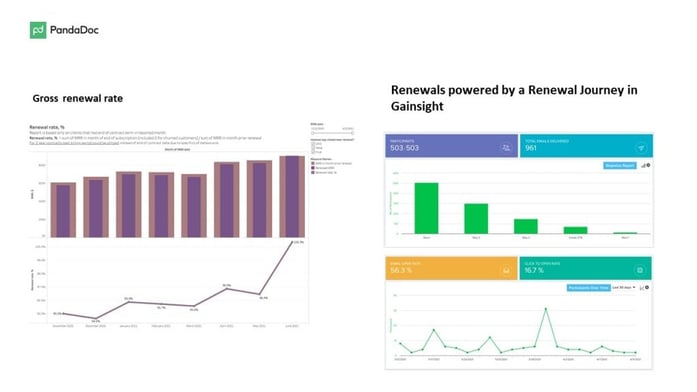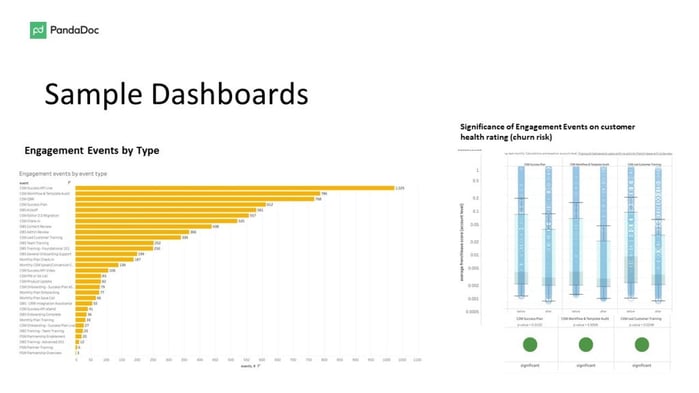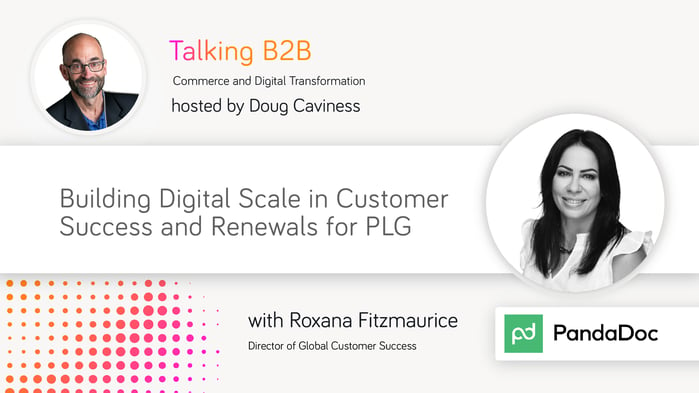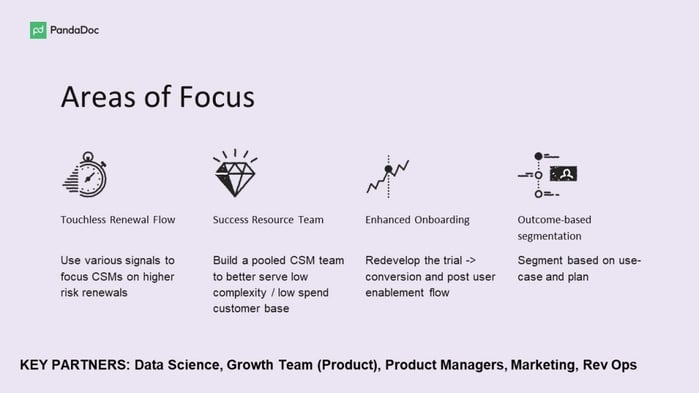Building Digital Scale in Customer Success and Renewals for PLG
PandaDoc Director of Global Customer Success Roxana Fitzmaurice joins us in this Q&A to share her expertise and insight on the role of customer …
Written by

Share this post
Subscribe for best practices on optimizing your software business.
Listen to this article
PandaDoc Director of Global Customer Success Roxana Fitzmaurice joins us in this Q&A to share her expertise and insight on the role of customer success in product led growth (PLG) and how radical collaboration has produced impressive results for PandaDoc.
Topics in this interview include:
-
Customer success evolution from renewals and expansion to success
-
Impact of tech touch on churn in the long tail customer segment
-
Orchestration between customer success and account management
But first, some quick facts about PandaDoc:
- Fast-growing SaaS document management company, founded in 2013
- Achieved 64% YoY revenue growth rate (2020) by employing product led growth (PLG) strategies
- Serves sales organizations of SMB companies
- More than 29,000 customers
- 350 employees globally
Journey from high touch to tech touch
Doug: You bring incredible insight about the changing role of customer success (CS) and renewals teams. You have led CS orgs on opposite ends of the spectrum, previously at Cisco WebEx where you led the CS team supporting the largest enterprise accounts engaged through high-touch motions. Now at PandaDoc you’re leading a CS team working at scale with thousands of SMB accounts where a lot of your success derives from continuously honing the customer journey, employing digital touch customer success and self-service for individual users and small departments.
Roxana: Yes, at Cisco WebEx we really followed LAER and partnered with large account teams where we delivered a very high-touch customer success experience and were engaged with the C-suite. It was more about managing people, interactions, expectations, and escalations. Cisco WebEx is a business-critical tool, and expectations are high. In contrast, at PandaDoc it’s more of a grass-roots effort where you move into small departments and users of SMB accounts, and then work to expand the footprint of the account.
Customer success evolution from renewals and expansion to success
Doug: How has your role evolved at PandaDoc since joining roughly two years ago?
Roxana: When I joined PandaDoc, the CS organization was fairly new, officially formed in April of that year by the VP of customer success. We had the challenge to educate internally that one of the traditional charters of CS is adoption and nurturing of clients. At that time, the CS organization was hyper-focused on renewals and expansion, and we had an opportunity to improve the churn metrics. It took us several months to re-educate internally that we need to focus on the initial stages of the customer journey, double down on onboarding, provide proactive nurturing activities to customers, and then that renewal becomes a non-event, and the expansion will occur. These are still priorities.
Obviously, it’s a CS and renewals organization so we’re constantly monitoring churn and contraction, removing those adoption blockers and our customer success managers (CSMs) still manage all the renewals and partner closely with our account management team on expansion opportunities.
Doug: Could you explain what you mean by reframing CS from being transaction-focused to being focused on customer adoption and expansion?
Roxana: When I started leading this organization we had CS coverage on a very small fraction of our customer base, maybe just 1,400 customers. Now we have CS coverage on 100% of our customer base by employing tech touch for the long tail, which has at the same time allowed us to increase coverage in the named customer success manager (CSM) model. Now we have a very structured post-sales customer journey mapped out.
It starts with success planning and takes the customer through to the renewal conversation. What we try to do is understand what touch points are critical along that journey. We partner very closely with the growth team in our product organization. They’re doing continuous in-app experiments, such as changing the trial pricing, iterating on the cancel flow within the app, or the expansion flow within the app. We partner very closely to make sure we’re still preserving the customer experience at both ends of the spectrum.
Rapid growth requires and is sustained through innovation
Doug: Could you speak to the tremendous growth and scale that you’re dealing with at PandaDoc?
Roxana: We ended 2020 with a 64% increase in net revenue, now in 2021 may exceed 70% YoY growth. In 2020, our average net revenue retention was 97%, and we ended May at 105%, so we’re making a big impact there. It’s a combination of bringing churn down and really building up and staffing our account management team to focus on the expand motion. We had a 44% increase in customers last year and 11% increase in our average revenue per count, and we added 24 CSMs to the organization as well. Today we support over 29,000 customers.
Doug: Could you speak a bit more about your use of automation?
Roxana: One of the things that we’re focused on is augmenting what we’re doing today with more automation. When we originally began building out the foundation of our CS organization it was about establishing the traditional CS touchpoints and hiring people with the appropriate skills. The CSM we hire now has a different profile than the CSM we hired a year ago. Now that we know what is working, we’re partnering with product and revenue operations, to build some automation.
We’re interested in a touchless renewal flow, and there’s a couple pieces of data that we’re trying to pull from our billing platform to help us with this. But we have certain signals that we will use to determine which customers should be sent this kind of automated renewal flow.
The way we would try this is through testing, likely through an email cadence, to find out what works and then build it in-app. So, when you enter the app, you are prompted based on your role. If you’re an admin who is responsible for the contract, you’d be prompted to go through a quick auto renewal in the app, we gain agreement and move on.
Today, we have a cadence that starts 120 days prior to renewal. The CSM meets with the customer. If there’s a possibility of expansion, we bring in an account manager to drive the conversation forward. Another signal that I can use now also is a recent expansion of the account, that’s a really good indicator of a customer that has intent to renew.
We’re building a pooled CS team to better serve the low complexity long tail customer base. We don’t have analytics today into what their needs are, what kind of inquiries are coming in. So, we’re going to use technology that will help manage the inbox, and also provide analytics into the types of inquiries these customers have.
Another area of extreme focus and importance is onboarding. We have onboarding that is sold through our sales team and delivered through our service delivery team, but for the other 80% of customers who don’t purchase services, we need to augment the onboarding experience. And by that, I mean, in-app, starting all the way from when the customer signs up for their free trial. There’s a certain experience they have. Once they hit the paywall, we want to develop a very prescriptive path based on use case and persona.
We’re just in the initial stages of enhancing the current experience and defining what it means for a customer to graduate from that onboarding phase. And when it is appropriate for CSMs to engage. We look at customer success and renewals as a team effort. It’s not just CSMs working with customers, it’s also about determining how that experience occurs within our application, and more broadly improving what we’re delivering with technology or automation.
Using KPIs and dashboards
Doug: What are some of the KPIs or dashboards you use to collaborate?
Roxana: There are quite a few sources of data that help us make a lot of our decisions. One of the things that we look at is engagement events that our CSMs conduct with our clients. That includes a variety of touches such as a success plan call, a CSM-led training, or QBR. By leveraging a strong partnership with our data science team, we can see which of these engagement events have a significant impact on customer health.
If you’re in customer success, you have a pretty good idea that doing success planning, training, business reviews, reviewing success metrics and sharing recommendations for improvement has an impact on customer health, and should lead to expansion. But it’s better to have the data and that’s something that’s very important at PandaDoc – back up what you’re doing with data.
Another thing we noticed is that workflow consultation is a very important engagement that our CSM can have with our customers. So, we’re going to double-down on that in Q3 of 2021 having our CSMs refocus attention on customers that have low health scores and offering these workflow consultations to help them with their use of the product.

Doug: It’s great that you’re able to measure the impact of your CS engagements. Was it just a matter of running a quick report or did it take iteration to achieve this?
Roxana: It takes time. When we first had this report delivered to us it said that none of these CS activities are significant. You can’t expect that a CSM has one quarterly business review with a customer and all of a sudden, their health shoots up, right? Success is a series of these little events over time that help the customer see more value.
We also look at net dollar retention, it’s important to understand what contributes to that. We also find it very important to measure gross revenue retention, so we look at each CSM’s book of business, and how many renewal dollars they retain. This way we know if the problem is with retention, or if the problem is with expansion.
We monitor gross renewal rate, and we look at it by CSM. We have a lot of dashboards in Gainsight as well, which is what we use to manage our customer relationships. We also have a lot of journeys built based on the customer segment or the customer need, and today our renewal journey is also managed in Gainsight.

Impact of tech touch on churn in the long tail customer segment
Doug: Does shifting the long tail segment of customers to a pure tech touch where you only interact digitally result in a higher rate of churn than you’d see with human touch?
Roxana: It is important to understand the reasons for churn, have good data around that, share it with the right groups internally, and take action. One change we made this year was to route in-app cancel requests to CSMs so we gave the customer an opportunity to speak with someone about their potential change in need so we could augment their subscription as needed. So again, we partnered with the product team, and we built out a flow where it directs the customer to the CSM. Constant monitoring and review of cancel information will help you revise your approach.
Orchestration between customer success and account management
Doug: How does your customer success team partner and manage hand offs with the account management team?
Roxana: That’s a great one because I feel like we’re finally in a good place in terms of how our CSMs partner with account managers. Leaders of both teams meet frequently and partner closely to align the targets in our comp plans. Constant communication between teams makes sure we’re aligned on targets. We revisit our handoffs constantly and educate the team about the right way to partner. We do role plays in team meetings.
We invite account managers (AMs) to every customer call. We want customers to know that AMs are a part of the account team. AMs and CSMs are introduced to the customer during the onboarding process, so they know who they’ll be working with. This level of partnership takes time and continuous enablement. It took two or three quarters of listening to each other, discussing the challenges, really calling out who does what in a meeting, who speaks to what, and again, inviting the AMs to every meeting. I think we’re going to see more growing pains around that as we move into enterprise, and we’ll probably see the AM play a much larger role in the renewal discussion.
We’ll figure it out together by taking the time to collaborate and understand what works. And expansion is still 30% of my CSMs’ comp plan so it really aligns our interests with those of our AM team.

Doug: How have you determined what should be handled by customer success versus support or the product team?
Roxana: When I talked about adding 24 CSMs last year, part of that was the result of combining the high velocity team that sat in our support organization so we could have a more streamlined and standardized approach to how we engage with customers. Anytime we can streamline a process and allow a customer to self-serve, we will give it a shot. Not every customer-vendor interaction can be replaced with an in-app flow, but we have a digital and automation-first mindset, so we always have a brainstorm session around the best approach and when and how we should augment with humans.
About Roxana Fitzmaurice
Roxana is director of global customer success at PandaDoc. Prior to joining PandaDoc, Roxana worked for more than 16 years at Cisco and Cisco WebEx in a variety of leadership roles, including customer success enablement, customer success technology, and management of customer success teams. Find Roxana on LinkedIn.




